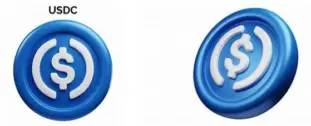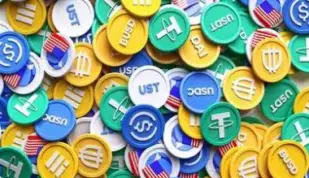USDC Explained: Transparency, USDT Comparison, and US Regulation
What Is USDC? The Most Transparent Stablecoin & How It Compares to USDT
USDC (USD Coin) is the digital dollar that actually plays by the rules. Pegged 1:1 to the U.S. dollar, USDC is issued by Circle in partnership with Coinbase under the Centre Consortium.
It’s built for stability, transparency, and regulatory compliance—three things crypto doesn’t always deliver. That’s why USDC has become a go-to asset for traders, DeFi users, and institutions looking for a stablecoin that won’t rug them mid-transfer. USDC is the most popular example of a fiat-backed stablecoin with strong U.S. regulation.

USDC’s Core Mechanism: Fiat Reserves and Audits
Every USDC token is backed 1:1 by a real U.S. dollar held in regulated U.S. bank accounts and short-duration Treasury bills. These reserves are audited monthly by major accounting firms like Deloitte, and the reports are publicly available. This strict adherence to Proof-of-Reserve protocols is why USDC is widely considered the most transparent stablecoin in the game, emphasizing compliance over absolute decentralization.
Technical Standards and Primary Use Cases
- ERC-20 token standard with multi-chain support (Ethereum, Polygon, Solana, etc.).
- Smart contract-based issuance and burning ensuring full transparency of supply.
- 100% fiat-backed reserves verified by independent third-party audits.
What Can You Do with USDC?
- Store value during market volatility (acting as a stable hedge).
- Send cheap, fast international payments via Layer-2 networks.
- Use as collateral in major DeFi protocols (Aave, Compound, MakerDAO).
- Trade against other crypto assets on major exchanges as the preferred stable trading pair.
Multi-Chain USDC: Supported Networks and Transfer Best Practices
USDC is available across multiple blockchains, making it flexible and gas-efficient depending on your needs. This multi-chain support is managed through official bridge mechanisms by Circle, maintaining the one-to-one peg across chains.
USDC-Compatible Networks (Choosing the Right One)
Choosing the right network depends on your priority (security, cost, or speed):
- Ethereum (ERC-20) — Highest security but expensive gas fees. Ideal for large transfers.
- Polygon, BNB Smart Chain — Low fees, high compatibility (EVM).
- Solana — Blazing fast, ultra-low fees.
- Arbitrum & Optimism — Layer 2 scaling for Ethereum (best balance of security/cost).
- Avalanche, Base — Great for native DeFi and NFT ecosystems.

How to Transfer USDC Safely
- Select your destination network (ERC-20, BEP-20, Solana, etc.).
- Confirm the recipient wallet supports that exact network.
- Double-check the wallet address.
- Pay the gas fee and send.
Warning: Sending USDC on the wrong network will result in permanent loss of funds. Always verify the network.
Where to Buy & Store USDC
You can acquire USDC across both centralized and decentralized venues. Buying is easy on major cryptocurrency exchanges like Binance, Coinbase, and Bybit, where USDC serves as a crucial stable trading pair. Alternatively, users engage in decentralized swaps via protocols like Uniswap and PancakeSwap. Once acquired, securing your USDC is paramount. For the highest level of protection against digital threats, cold storage via hardware wallets like Ledger or Trezor is highly recommended, offering physical security for your private keys.
For active DeFi and Web3 interaction, the choice of software wallet depends on your needs. MetaMask is the industry standard browser extension, providing direct access to the vast Ethereum and EVM-compatible DeFi ecosystem.
For mobile-first users seeking simplicity and extensive multi-chain support, Trust Wallet offers a secure and intuitive environment to manage assets across dozens of networks. Lastly, Exodus is a popular desktop and mobile choice known for its beautiful design and integrated exchange features, making it ideal for multi-currency management.
While exchange wallets offer convenience, they are generally the least secure option for long-term holding of significant capital, as you do not control the private keys.
USDC vs USDT: Transparency, Regulation, and Risks
The core debate in the stablecoin space centers on trust. USDC and USDT are both fiat-backed, but their approach to reserves and regulatory compliance is vastly different. This impacts risk and censorship resistance.
| Feature | USDC (USD Coin) | USDT (Tether) |
|---|---|---|
| Issuer / Regulator | Circle (U.S.) / U.S.-regulated | Tether Ltd. (BVI) / Looser oversight |
| Reserves Breakdown | 100% Fiat & T-Bills, monthly audited by Deloitte | Mixed assets (fiat, bonds, commercial paper), less frequent/transparent audits |
| Reserve Transparency | Full and frequent public reports (Proof-of-Reserve) | Partial and less frequent attestations |
| Censorship Risk (Freezing) | Moderate (U.S. legal compliance can freeze assets) | Low to Moderate |
| DeFi Usage | High (Preferred by Institutions and regulated DeFi) | Very High (High liquidity, strong trading pair) |
For institutional investors and compliance-driven businesses, the role of the Centre Consortium cannot be overstated. USDC’s structure is governed by this body, founded by Circle and Coinbase, ensuring that the smart contract governance adheres strictly to U.S. financial reporting standards.
This commitment means that while USDC offers immense digital utility, it is also subject to regulatory action, which includes the ability to freeze assets in response to legal or compliance requirements—a critical consideration for users prioritizing absolute censorship resistance over regulated assurance. Understanding this trade-off between compliance and decentralization is essential for any serious stablecoin holder.
A frequent query among advanced users concerns the precise USDC reserve breakdown. While the full audits are public, it is important to note that a significant portion of the reserves is held in short-duration U.S. Treasuries and cash, providing high liquidity and stability, but subjecting the asset’s yield to central bank policy.
This focus on traditional assets makes USDC the preferred on-ramp for traditional finance (TradFi) and sets a benchmark for stablecoin regulation globally. For those using USDC for high-volume transactions, its deep liquidity across Layer-1 and Layer-2 solutions ensures seamless execution, making it the most reliable tool for bridging traditional banking infrastructure with the rapidly evolving DeFi economy.
Conclusion: USDC’s Role as the Compliant Stablecoin
USDC maintains its position as the compliant, transparent stablecoin of choice for mainstream finance and institutional players. Its strength lies in its audited reserves and commitment to U.S. regulation, making it a safer bridge between traditional finance and the crypto economy. While decentralized stablecoins like DAI offer greater censorship resistance, USDC provides the crucial elements of trust and regulatory clarity that are essential for the next wave of global adoption.
Disclaimer / No Liability
By using this site, you agree that all actions are at your own risk and you release the site owners and authors from any liability.
